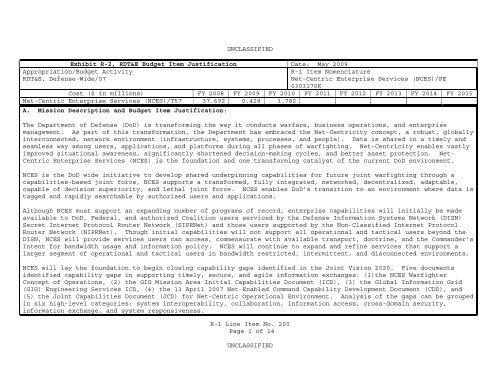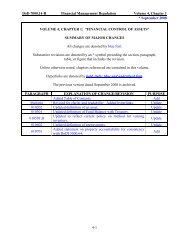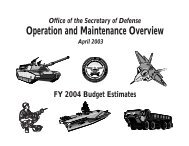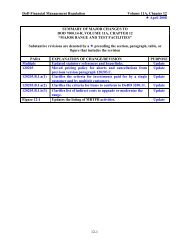Defense Information Systems Agency - Office of the Under Secretary ...
Defense Information Systems Agency - Office of the Under Secretary ...
Defense Information Systems Agency - Office of the Under Secretary ...
- No tags were found...
Create successful ePaper yourself
Turn your PDF publications into a flip-book with our unique Google optimized e-Paper software.
UNCLASSIFIED<br />
Exhibit R-2, RDT&E Budget Item Justification Date: May 2009<br />
Appropriation/Budget Activity<br />
RDT&E, <strong>Defense</strong>-Wide/07<br />
R-1 Item Nomenclature<br />
Net-Centric Enterprise Services (NCES)/PE<br />
0303170K<br />
Cost ($ in millions) FY 2008 FY 2009 FY 2010 FY 2011 FY 2012 FY 2013 FY 2014 FY 2015<br />
Net-Centric Enterprise Services (NCES)/T57 37.692 0.428 1.782<br />
A. Mission Description and Budget Item Justification:<br />
The Department <strong>of</strong> <strong>Defense</strong> (DoD) is transforming <strong>the</strong> way it conducts warfare, business operations, and enterprise<br />
management. As part <strong>of</strong> this transformation, <strong>the</strong> Department has embraced <strong>the</strong> Net-Centricity concept, a robust, globally<br />
interconnected, network environment (infrastructure, systems, processes, and people). Data is shared in a timely and<br />
seamless way among users, applications, and platforms during all phases <strong>of</strong> warfighting. Net-Centricity enables vastly<br />
improved situational awareness, significantly shortened decision-making cycles, and better asset protection. Net-<br />
Centric Enterprise Services (NCES) is <strong>the</strong> foundation and one transforming catalyst <strong>of</strong> <strong>the</strong> current DoD environment.<br />
NCES is <strong>the</strong> DoD wide initiative to develop shared underpinning capabilities for future joint warfighting through a<br />
capabilities-based joint force, NCES supports a transformed, fully integrated, networked, decentralized, adaptable,<br />
capable <strong>of</strong> decision superiority, and lethal joint force. NCES enables DoD’s transition to an environment where data is<br />
tagged and rapidly searchable by authorized users and applications.<br />
Although NCES must support an expanding number <strong>of</strong> programs <strong>of</strong> record, enterprise capabilities will initially be made<br />
available to DoD, Federal, and authorized Coalition users serviced by <strong>the</strong> <strong>Defense</strong> <strong>Information</strong> <strong>Systems</strong> Network (DISN)<br />
Secret Internet Protocol Router Network (SIPRNet) and those users supported by <strong>the</strong> Non-Classified Internet Protocol<br />
Router Network (NIPRNet). Though initial capabilities will not support all operational and tactical users beyond <strong>the</strong><br />
DISN, NCES will provide services users can access, commensurate with available transport, doctrine, and <strong>the</strong> Commander’s<br />
Intent for bandwidth usage and information policy. NCES will continue to expand and refine services that support a<br />
larger segment <strong>of</strong> operational and tactical users in bandwidth restricted, intermittent, and disconnected environments.<br />
NCES will lay <strong>the</strong> foundation to begin closing capability gaps identified in <strong>the</strong> Joint Vision 2020. Five documents<br />
identified capability gaps in supporting timely, secure, and agile information exchanges: (1)<strong>the</strong> NCES Warfighter<br />
Concept <strong>of</strong> Operations, (2) <strong>the</strong> GIG Mission Area Initial Capabilities Document (ICD), (3) <strong>the</strong> Global <strong>Information</strong> Grid<br />
(GIG) Engineering Services ICD, (4) <strong>the</strong> 13 April 2007 Net-Enabled Command Capability Development Document (CDD), and<br />
(5) <strong>the</strong> Joint Capabilities Document (JCD) for Net-Centric Operational Environment. Analysis <strong>of</strong> <strong>the</strong> gaps can be grouped<br />
in six high-level categories: system interoperability, collaboration, information access, cross-domain security,<br />
information exchange, and system responsiveness.<br />
R-1 Line Item No. 200<br />
Page 1 <strong>of</strong> 14<br />
UNCLASSIFIED
















